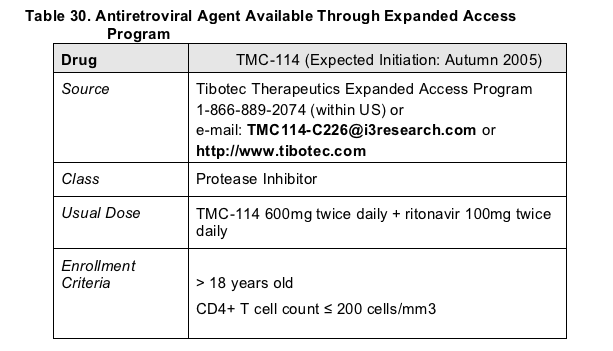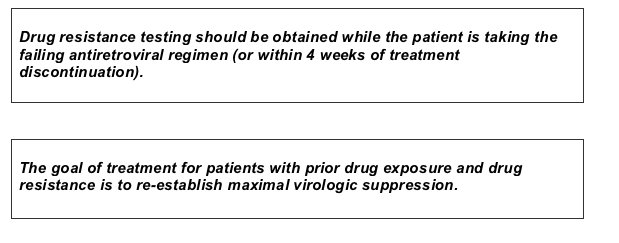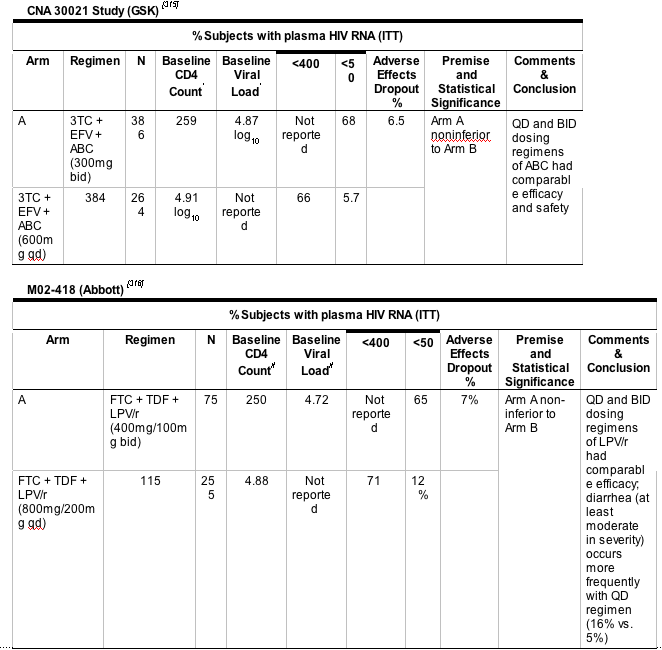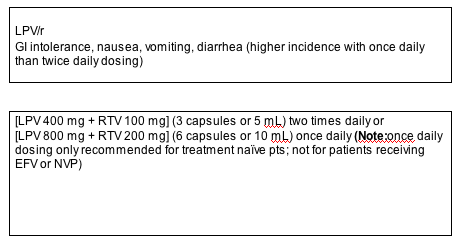| |
HHS HIV Treatment Guidelines Updates by Panel and
MANAGEMENT OF THE TREATMENT - EXPERIENCED PATIENT
|
| |
| |
KEY SELECTED HIGHLIGHTS

ADDITIONAL ENROLLMENT CRITERA
Received treatment from each of the three major classes (NNRTIs, PIs, and NRTIs) including 2 different PI-based regimens.
Have limited or no treatment options due to virologic failure or intolerance to multiple ARV regimens.
The Panel recommends that a regimen containing "tenofovir + didanosine + NNRTI" should not be used as an initial regimen in antiretroviral treatment naive patients.
This recommendation is based on results from several small observational studies and pilot clinical trials showing a high rate of early virologic failure in treatment-naive patients who received this combination as their initial regimen. Emergence of resistant mutations to NNRTIs and to tenofovir and/or didanosine (K65R or L74V mutations) was frequently seen in patients who failed to respond to this combination [1-4]. Of note, patients with high baseline HIV-RNA (> 100,000 copies/mL) and low CD4+ T-cell counts (< 200 cells/mm3) were particularly at risk of early virologic failure. There are not enough data for the combination of tenofovir/didanosine with protease inhibitor in treatment-naive patients to assess virologic responses of this regimen, thus, there is no recommendation for or against the use of this combination at this time.
The Panel recommends that lopinavir/ritonavir can be dosed as one single daily dose (6 capsules or 10 mL - equivalent to 800mg lopinavir/200mg ritonavir) in treatment-naive patients.
Once daily dosing is not recommended in treatment-experiences patients or in patients receiving concomitant efavirenz, nevirapine, amprenavir (or fosamprenavir), or nelfinavir.
This recommendation is based on 48-week data from two clinical trials comparing once vs. twice daily lopinavir/ritonavir, used in combination with tenofovir + emtricitabine in treatment-naive patients, demonstrating similar virologic responses in both treatment arms.
Once daily dosing has not been studied in treatment-experienced patients. In the pharmacokinetic study, the trough concentration of lopinavir at the end of a 24 hour dosing interval was found to be approximately 60% lower than with twice daily dosing. Given the lower trough concentration and no clinical trial data in treatment-experienced patients, once daily dosing is currently not recommended in these patients.
It is also important to note that moderate to severe diarrhea were reported significantly more frequently in subjects who received once daily lopinavir/ritonavir as compared to twice daily dosing (16% vs. 5% respectively) [5].
Reusing prior medications (even with documented drug resistance) may provide some degree of partial antiretroviral activity.

Although heterogeneous, patients who experience treatment failure may be divided into those with
- limited prior treatment and drug resistance who have adequate treatment options;
- an intermediate amount of prior treatment and drug resistance with some available treatment options; and
- extensive prior treatment and drug resistance who have some or no adequate treatment options.
The assessment, goals of therapy and approach to managing treatment failure differ for each of these three groups.
Extensive prior treatment and drug resistance: In patients with active antiretroviral agents available (e.g. an active ritonavir-boosted PI and enfuvirtide), the goal of therapy is suppression of viremia. In patients without active antiretroviral agent available and with ongoing viremia, the goal of therapy is preservation of immune responses and delay of clinical progression.
Immunologic failure (or blunted CD4 response) with virologic suppression: Immunologic failure (or blunted CD4 cell response) may not warrant a change in therapy in the setting of suppressed viremia. Assess for other causes of immunosuppression (e.g. HIV-2, HTLV-1, drug toxicity). The combination of didanosine and tenofovir has been associated with CD4 cell declines or blunted CD4 cell responses. In the setting of immunologic failure (or blunted CD4 response), it would be reasonable to change one of these drugs (BIII). Intensifying with additional antiretroviral drugs or the use of immune-based therapies (e.g. interleukin-2) to improve immunologic responses remain unproven strategies and generally should not be offered (DII).
Changing an Antiretroviral Therapy Regimen for Virologic Failure
Panel's Recommendations:
- For the patient with virologic failure, perform resistance testing while the patient still is taking the drug regimen or within 4 weeks after regimen discontinuation (AII).
- Use the treatment history and past and current resistance test results to identify active agents (preferably at least two fully active agents) to design a new regimen (AII). A fully active agent is one likely to demonstrate antiretroviral activity on the basis of both the treatment history and susceptibility on drug-resistance testing.
- If at least two fully active agents cannot be identified, consider pharmacokinetic enhancement of protease inhibitors (with the exception of nelfinavir) with ritonavir (BII) and/or re-using other prior antiretroviral agents to provide partial antiretroviral activity (CIII).
- Adding a drug with activity against drug-resistant virus (e.g. a potent ritonavir-boosted PI) and a drug with a new mechanism of action (e.g. HIV entry inhibitor) to an optimized background antiretroviral regimen can provide significant antiretroviral activity (BII).
Optimally, a new active agent should be used with one or more other active agents in the regimen (e.g. a ritonavir-boosted PI and enfuvirtide) (BII)
- In general, one active drug should not be added to a failing regimen because drug resistance is likely to develop quickly (DII). However, in patients with advanced HIV disease (e.g. CD4 <100) and higher risk of clinical progression, adding one active agent (with an optimized background regimen) may provide clinical benefits and should be considered (CIII).
General Approach (Ideally, one should design a regimen with two or more fully active drugs (on the basis of resistance testing or new mechanistic class) (BII) [154, 192]. Some antiretroviral drugs (e.g. NRTIs) may contribute partial antiretroviral activity to an antiretroviral regimen.
With its novel mechanism of action, the HIV entry inhibitor enfuvirtide (T-20), was approved for treatment-experienced patients based on its demonstrated potent antiretroviral activity in heavily treatment-experienced patients [195-197]. Enfuvirtide has not been well studied in patients at earlier stages of HIV infection.
Although enfuvirtide routinely is given by subcutaneous injection twice daily, a needleless system (Biojector) may be more acceptable to some patients and better tolerated [198].
Sequencing and Cross Resistance. The order of use of some antiretroviral agents may be important. Cross-resistance among NRTIs is common but varies by drug. Most, if not all, NNRTI-associated resistance mutations confer resistance to all approved NNRTIs. Novel early mutations to some protease inhibitors (e.g., amprenavir, atazanavir, nelfinavir, saquinavir) that do not confer cross-resistance to other PIs may occur initially, but then subsequent accumulation of additional mutations confers broad cross-resistance to the entire protease inhibitor class.
Tipranavir/ritonavir was approved for use in patients who are highly treatment-experienced or have HIV-1 strains resistant to multiple PIs based on its demonstrated activity against PI-resistant viruses [199, 200]. However, with ongoing viremia and the accumulation of additional mutations, antiretroviral activity is time-limited unless the regimen contains other active drugs (e.g. an HIV entry inhibitor).
New Agents. Investigational reverse transcriptase inhibitors and protease inhibitors currently are under investigation in clinical trials. Some of these agents demonstrate distinct resistance patterns and activity against drug-resistant viruses [201].
Investigational drugs with newer mechanisms of action (e.g. HIV chemokine receptor inhibitors; HIV integrase inhibitors) demonstrate short-term antiretroviral activity in patients with resistance to the reverse transcriptase inhibitors and PIs [202-205] and are under investigation in clinical trials.
Current Approach. Several clinical trials illustrate effective therapeutic strategies for heavily treatment-experienced patients [195, 196, 199-201]. In these studies, patients received an antiretroviral regimen optimized on the basis of resistance testing and then were randomized to receive a new active antiretroviral agent or placebo. Patients who received more active drugs (e.g. an active ritonavir-boosted PI and enfuvirtide), had a better and more prolonged virologic response than those with fewer active drugs in the regimen [197].
Table 8. Antiretroviral Drugs and Components Not Recommended as Initial Therapy
Didanosine + tenofovir + NNRTI (DII)
- High rate of early virologic failure when didanosine and tenofovir are used in combination with efavirenz or nevirapine
- Rapid selection of resistant mutations
- Potential for immunologic non-response
Tipranavir (boosted with ritonavir) (DIII)
- Lack of data in treatment-naive patients


Table 12. Characteristics of Protease Inhibitors (PIs)
Tipranavir (TPV)/ Aptivus«
FORM: 250 mg capsules
DOSING RECOMMENDATIONS: 500 mg twice daily with ritonavir 200 mg twice daily Unboosted tipranavir is not recommended
FOOD EFFECT: Take both TPV & RTV with food. Bio-availability increased with high fat meal
ORAL BIOAVAILABILITY: Not determined
SERUM HALFLIFE: 6 hours after single dose of TPV/ RTV
ROUTE OF METABOLISM: TPV -Cytochrome P450 (3A4 inducer and substrate)
Net effect when combined with RTV - CYP 3A4 inhibitor and CYP 2D6 inhibitor
STORAGE: Refrigerated capsules are stable until date on label; if stored at room temperature (up to 25║C or 77║F) - must be used within 60 days
ADVERSE EFFECT:
- Hepatotoxicity - clinical hepatitis including hepatic decompensation has been reported, monitor closely, esp. in patients with underlying liver diseases. Extra vigilance is warranted in patients with HCV & HBV, as these patients have extra risk for hepatoxicity.
- Skin rash - TPV has a sulfonamide moiety, use with caution in patients with known sulfonamide allergy
- Hyperlipidemia (esp. hypertriglyceridemia)
- Hyperglycemia
- Fat maldistribution
- Possible increased bleeding episodes in patients with hemophilia
Dosing in Hepatic Impairment:
No dosage recommendation; use with caution in patients with hepatic impairment; TPV/RTV is contraindicated in pts with moderate to severe (Child-Pugh Class B & C) hepatic insufficiency
TPV/RTV - contraindicated in patients with severe hepatic inefficiency for other patients follow "frequently" during treatment.. Clinical hepatitis & hepatic decompensation with TPV/RTV have been reported. Underlying liver disease increases risk.
Female gender associated with an increased frequency of skin rash.. Rash accompanied by joint pain, stiffness, throat tightness, or generalized pruritis reported. 33% in female subjects in Phase I study with ethinyl estradiol. 3-10% skin rash in males & 14% in females in Phase II & III studies.
|
|
| |
| |
|
|
|